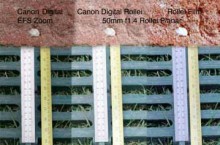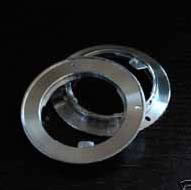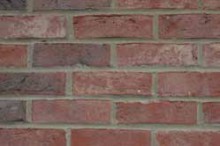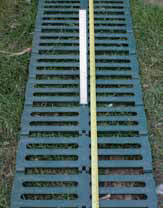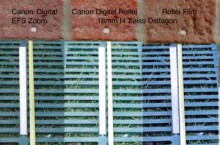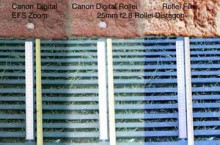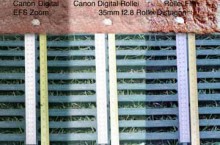In Issue 10, I wrote about ‘digital contact sheets’; how I’d borrowed a friend’s Canon EOS 300D and photographed a negative sheet and converted the colour negatives into a positive, showing 4 strips of 3 x 120 frames on one sheet and that a bit more work was needed to improve the results. Well, these challenges tend to simmer on the back burner. The first step was to purchase a camera for myself.
Canon or Nikon?
Having successfully used a Canon in my preliminary tests, this was a starting point. I thought about a Nikon too. The problem is where to start; new models are produced with regular monotony and are aimed at different sectors of the market. I did not want bells and whistles nor did I need top quality so, a beginner’s camera was an obvious choice. I researched both makes. Two things immediately came to the forefront; firstly that Canon EOS cameras had been designed with a large lens mount throat and could take adapters which enabled many other manufacturers’ manual lenses to be fitted including Rollei 35mm QBM mount lenses; secondly, that second-hand Canon digital cameras sold for less on Ebay than the equivalent Nikon digitals.
Which Canon?
I knew that the 300D did what I wanted it to but this was now long in the tooth, the 350D had a similar 6K sensor resolution; the 400D had a 10K sensor; the 450D had a 12K sensor and the 500D is the current model. The prices were about £100 difference for each model so the 300D reached about £100; the 350D about £200; the 400D about £300; the 450D about £400 etc.. I decided that a 400D would give me sufficient quality for a reasonable outlay.
I watched, waited and managed to find a boxed 400D with standard Canon ‘kit’ 18-55mm EF-S (ElectroFocus- Stabilised) f3.5-f5.6 zoom lens for under £300. Again from Ebay, I ordered a basic Rollei to EOS lens adapter from Hong Kong for £10 – not an expensive accessory.
I have subsequently found that it is possible to get some adapters with an ‘AF Confirm’ chip. These are not yet available in Rollei QBM but a chip can be purchased and could be fitted if required. The chip sits where the stop-down pin is situated on the Rollei lens – possibly this is why they are not commercially available. The addition of this chip enables the focus confirm LEDs in the viewfinder to light when focus is achieved. This is a good idea – see my reasoning further down.
Canon EOS 400D is rubbish…or is it?
When the camera arrived, I had a play whilst reading the manual. I took some portrait ‘snaps’ and magnified the images on the LCD at the back of the camera. My immediate reaction was ‘these are not sharp’ when looking at the subject’s eyes and hair; “Rubbish digital” I thought, “wait till I try my Rollei lenses!”. When the adapter arrived, I took some comparative shots with the Canon lens and a Rollei lens. The Rollei lens’ results were worse still! “How can this be?” Down to some serious thinking and testing...
The EOS lens ‘talks’ to the camera, the Rollei does not; Canon has ‘image stabilisation’, Rollei does not; in-camera digital processing sharpens the images and adjusts contrast and colour. Perhaps this was not happening with a Rollei lens attached. The viewfinder screen on the Canon is quite small – the sensor is basically a ‘half-frame’ one; it has no rangefinder wedge and micro-prisms to aid focusing. The image does not ‘snap’ into focus.
Test 1 – Fixed distance, ISO and aperture
I mounted the camera on a tripod and pointed the camera at a brick wall at a distance of 1 metre. I set the camera sensor to 200ASA, the aperture to f8 on aperture priority. The camera set the shutter speed to about 1/100th. I took photographs of the brick work at 18mm, 25mm, 35mm and 50mm with the Canon zoom. I then attached the adapter to each of my test lenses in turn; 18mm f4 Zeiss Distagon; 25mm f2.8 Rollei Distagon; 35mm f2.8 Rollei Distagon and 50mm f1.4 Rollei Planar. I then swapped the camera body for my Rolleiflex 3003 and took the same sequence of photographs. I also used a 28mm f2.8 Schneider Kreuznach perspective control shift lens; 35mm f1.4 Zeiss Distagon and the 50mm f4 Zeiss Distagon from my SL66 using the Rolleiflex SL66 to SL35 adapter that I ‘snatched up’ on Ebay because the seller did not know what it was. More about that another time!
Checking the Canon LCD screen again, I was not convinced that the Rollei lens’ photos were sharp. Furthermore the camera was over-exposing with the Rollei lenses by about 2 stops although the camera was still set on aperture priority and the lenses set to f8 too. The camera had similarly shown a shutter speed of about 1/100th with the Rollei lenses. Maybe the lenses were not focussing at the correct plane although the image appeared sharp on the focussing screen. Maybe the digital lens allows light to fall on the meter differently to the Rollei lenses. Because the digital sensor is like a honeycomb, with each of the sensor elements in a little ‘tube’ within the honeycomb, the digital lenses are designed to be ‘telecentric’, in other words, the light rays passing out from the rear of the lens are almost parallel and thus nearly perpendicular to the sensor array. With a non-digital lens, the light rays diverge and strike the film plane at an angle proportional to the distance from the lens axis. This is an over-simplification of the difference between an ‘analogue’ lens and a ‘digital’ lens. For this reason, focus and exposure readings for the two lens types 25 may be interpreted differently by the camera’s computer.
A slight divergence at this point is that the new Leica M9 digital rangefinder camera with full frame sensor has incorporated angled micro-lenses into the sensor elements to re-align the diverging light rays from a Leica ‘analogue’ film lens perpendicularly onto the sensor so, most Leica ‘M’ lenses can be used without vignetting or light ‘fall-off’.
Test 2 – 45 degree photo to find focal distance
Anyway, on to test No.2. I rolled out some garden pathway on the grass (having chased the chickens away), mounted the Canon on a tripod with the lens pointing downwards at 45 degrees. I laid out a tape measure on top of the pathway and set up a steel rule at 45 degrees, parallel to the camera’s ‘film’ plane. The distance from the sensor to the steel rule was measured and the tape measure moved so that the correct distance on the tape scale coincided with the tip of the steel rule. I wanted to check that the lens was focusing at the correct distance and would be able to check the sharpest section on the tape measure. I should add here, that I have had a suspicion that the focusing screen on my 3003 was not correctly collimated to the film plane, because when a lens was turned to infinity focus, the micro-prisms never completely ‘cleared’. The camera had been sent for repair on a couple of occasions and it is possible this was not checked accurately on re-assembly. This test would confirm or otherwise my suspicions.
I ‘rattled’ through the same sequence of tests (chasing the chickens away from time to time; they kept finding spiders etc. in the pathway slots!) with the lenses and camera bodies. However, this time I also, when the Rollei lenses were on the 3003, set the focus on the lens scale as opposed to just using the viewfinder screen. On checking the images on the Canon’s LCD screen, I became more convinced that I would have to ‘eat my hat’ because the digital images with Canon lens were so much better than the images taken with Rollei lenses. The Canon zoom lens gave quite sharp, contrasty, well exposed pictures with good colour rendition. With a Rollei lens, the Canon produced blurry, overexposed, flat pictures.
I would have to wait until the film came back from the camera shop to see what a Rolleiflex 3003 could do with a Rollei lens. After all, the Canon is basically a half frame camera and the image has to be enlarged considerably more than a full frame negative (although this does not apply if one is enlarging a section of the image taken with the same focal length lens). When I collected the film, the 7x5 prints looked good. I would have to enlarge them to do a fair comparison. I scanned the negatives onto my computer to give the same proportional pixel dimensions as the Canon digital images. I then enlarged the images on screen to give the same area of detail. As can be seen from the sections printed here, the Canon with zoom lens produces good images. The Rollei lens on the Canon is over exposed and so has lost a lot of fine detail (having been over exposed) as a result. This can be compensated for with more trial and error testing. The over exposure has affected the sensor’s ability to accurately record detail but you will note in the 50mm test, that the Rollei lens on the Canon has produced finer detail in the metal rule scale than the Canon lens.
Scanning Negatives for comparison
I would like to think that I should be able to expect this to be so when comparing a ‘plastic’ zoom lens weighing 184 grams compared to a metal and glass prime lens weighing twice as much. The scanned negatives have produced grainy images. When scanning a negative/transparency, there is an issue of light rays being reflected/refracted off film grains affecting the way the detail is recorded as a digital image. This causes a ‘grittiness’ in the image at high magnification. The detail on the metal rule scale is of similar ‘readability’ to that taken with the Rollei lens on the Canon. A fairer comparison would be to enlarge directly from the negative and compare the print with the digital print to the same scale. In fact, there was a test on the Gadget Show, some months ago now, where they compared a full frame film image taken on a Nikon F5 to a full frame digital image from a Nikon D700, both enlarged to 17 metres tall. The presenters’ comment was that the digital image was sharper and overall better and that the film image was grainy and had colour rendition issues. The Gadget Show extract can be seen at http://fwd. five.tv/gadget-show/videos/challenge/challenge-blow-uppart- 3 . Some viewers’ comments on this test can be seen on the Amateur Photographer Forum.
Conclusion - My not so tasty hat
In conclusion, as far as my test was concerned, besides the fact that my hat did not taste very good and was a bit leathery, I am impressed with the capability of a basic model of digital SLR camera that was introduced three years ago. When using it for ‘grab’ shots and action shots, the auto focus is fast; the image stabilisation can counteract the tendency to still be moving whilst releasing the shutter for those ‘grab’ shots. It seems to process colour and contrast to give a good image. The limited ‘dynamic range’ of the digital sensor means that it cannot record very contrasty scenes. I took some ‘contrejour’ photos of my daughter horse riding on the beach. The histogram flashed showing the highlights that had burnt out but in this instance, I think that this worked in my favour, concentrating attention on the subject. I apologise, this is not about Canon digital cameras!
To use a Rollei or other manual lens on a Canon digital camera is an option. You do lose most of the ‘auto’ features of the camera; aperture stop-down is manual; focusing is manual; exposure is not consistent/reliable. I would say the combination is best suited to slow methodical picture taking – but that’s what Rolleiflex photography is about anyway.
Rollei Lenses on a Canon... be careful
Not all Rollei lenses can be used. The rear element on the 50 mm f1.8 Planar fouls the mirror (the 50mm f1.4 Planar is OK). With a full frame digital EOS-1Ds or EOS-5D which have a larger mirror, care should be taken but there is a lot of information on the Internet with this regard. The larger barrelled Rollei lenses, ie the 35mm f1.4 Distagon and 85mm f1.4 Planar have a larger barrel diameter than the adapter, so it is difficult to grip the thin adapter when attaching and removing it from the lenses. In use, the adapter just bayonets on to the lens and then the assembly is fitted to the camera in the usual way. You have to be careful to depress the lens stop-down pin when attaching the adapter to the lens, otherwise the stop-down plate on the adapter will cause the lens pin to become bent. There is no catch release mechanism on the adapter so I use a cocktail stick to wedge the locking catch out of the lens locking slot to allow the lens to be rotated. Three hands and fifteen digits would make it easier. Of course you have to be wary of dust getting into the digital camera and onto the sensor, whilst changing lenses.
The 400D and later cameras do have an automatic sensor cleaning process every time you switch the camera on or off. The adapter does give the opportunity to use other lenses from one’s stable on a Canon EOS without having to buy new ones but it is not quite as simple nor reliable as one is led to believe. Although I am impressed with the results from my Ebay purchase, I do not plan to put my Rolleiflex collection up for sale just yet. There is something about the nail biting whilst waiting for the film to come back from the processors. Having said that, there are some situations where digital really does have the edge.
It is a shame that Rollei did not put a digital back for the 2000/3000 into production. Having more closely studied the negatives from the test - when using the screen to focus as compared to using the scale on the lens, my 3003 does seem to be focusing further away from the camera than the focussing screen shows. This confirms the fact that the screen image does not quite reach infinity focus but that the film image does and also that at close range, the photographs are not really sharp. There is also potential loss of quality when scanning negatives caused by the sensor receptors not accurately being able to resolve the irregular shape of the film grains.
